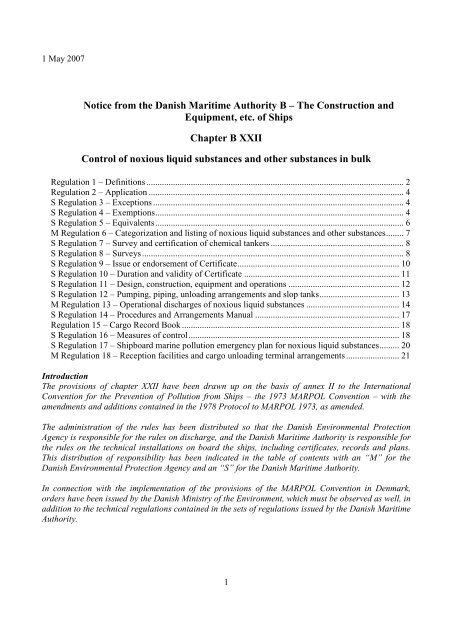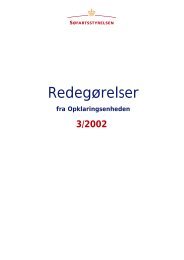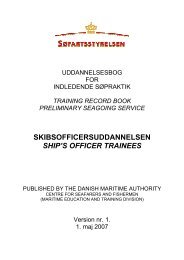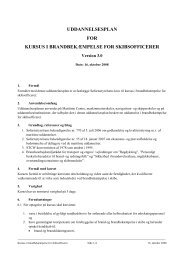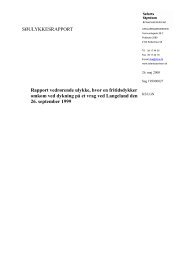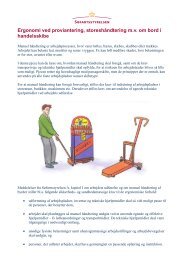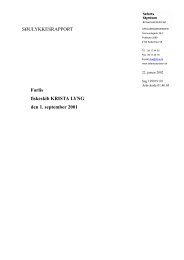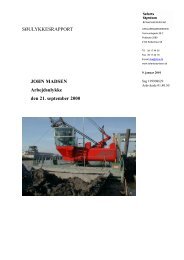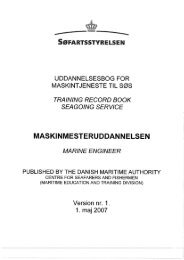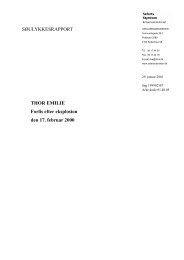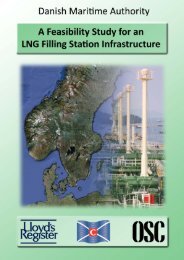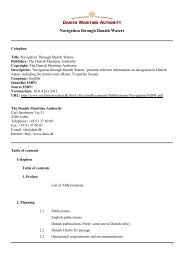22Chapter B XXII ok-ARI Sagsbeh CGE pdf
22Chapter B XXII ok-ARI Sagsbeh CGE pdf
22Chapter B XXII ok-ARI Sagsbeh CGE pdf
- No tags were found...
You also want an ePaper? Increase the reach of your titles
YUMPU automatically turns print PDFs into web optimized ePapers that Google loves.
1 May 2007Notice from the Danish Maritime Authority B – The Construction andEquipment, etc. of ShipsChapter B <strong>XXII</strong>Control of noxious liquid substances and other substances in bulkRegulation 1 – Definitions .................................................................................................................... 2Regulation 2 – Application ................................................................................................................... 4S Regulation 3 – Exceptions ................................................................................................................. 4S Regulation 4 – Exemptions................................................................................................................ 4S Regulation 5 – Equivalents................................................................................................................ 6M Regulation 6 – Categorization and listing of noxious liquid substances and other substances........ 7S Regulation 7 – Survey and certification of chemical tankers ............................................................ 8S Regulation 8 – Surveys...................................................................................................................... 8S Regulation 9 – Issue or endorsement of Certificate......................................................................... 10S Regulation 10 – Duration and validity of Certificate ...................................................................... 11S Regulation 11 – Design, construction, equipment and operations .................................................. 12S Regulation 12 – Pumping, piping, unloading arrangements and slop tanks.................................... 13M Regulation 13 – Operational discharges of noxious liquid substances .......................................... 14S Regulation 14 – Procedures and Arrangements Manual ................................................................. 17Regulation 15 – Cargo Record Bo<strong>ok</strong> .................................................................................................. 18S Regulation 16 – Measures of control............................................................................................... 18S Regulation 17 – Shipboard marine pollution emergency plan for noxious liquid substances......... 20M Regulation 18 – Reception facilities and cargo unloading terminal arrangements........................ 21IntroductionThe provisions of chapter <strong>XXII</strong> have been drawn up on the basis of annex II to the InternationalConvention for the Prevention of Pollution from Ships – the 1973 MARPOL Convention – with theamendments and additions contained in the 1978 Protocol to MARPOL 1973, as amended.The administration of the rules has been distributed so that the Danish Environmental ProtectionAgency is responsible for the rules on discharge, and the Danish Maritime Authority is responsible forthe rules on the technical installations on board the ships, including certificates, records and plans.This distribution of responsibility has been indicated in the table of contents with an “M” for theDanish Environmental Protection Agency and an “S” for the Danish Maritime Authority.In connection with the implementation of the provisions of the MARPOL Convention in Denmark,orders have been issued by the Danish Ministry of the Environment, which must be observed as well, inaddition to the technical regulations contained in the sets of regulations issued by the Danish MaritimeAuthority.1
In these provisions, the IMO is referred to as the Organisation, MARPOL 73/78 is referred to as theConvention, and the Danish Environmental Protection Agency and the Danish Maritime Authority,respectively, are referred to as the Administration.Part 1 – GeneralRegulation 1 – DefinitionsFor the purposes of this Chapter:1 “Anniversary date” means the day and the month of each year which will correspond to the date ofexpiry of the International Pollution Prevention Certificate for the Carriage of Noxious LiquidSubstances in Bulk.2 “Associated piping” means the pipeline from the suction point in a cargo tank to the shoreconnection used for unloading the cargo and includes all ship’s piping, pumps and filters which arein open connection with the cargo unloading line.3 Ballast water“Clean ballast” means ballast water carried in a tank which, since it was last used to carry a cargocontaining a substance in category X, Y or Z, has been thoroughly cleaned and the residuesresulting therefrom have been discharged and the tank emptied in accordance with the appropriaterequirements of this Chapter.“Segregated ballast” means ballast water introduced into a tank permanently allocated to thecarriage of ballast or cargoes other than oil or noxious liquid substances as variously defined in thepresent Convention, and which is completely separated from the cargo and oil fuel system.4 Chemical Codes“Bulk Chemical Code” means the Code for the Construction and Equipment of Ships carryingDangerous Chemicals in Bulk adopted by the Marine Environment Protection Committee of theOrganization by resolution MEPC.20(22), as amended by the Organization, provided that suchamendments are adopted and brought into force in accordance with the provisions of article 16 ofthe present Convention concerning amendment procedures applicable to an appendix to an Chapter.“International Bulk Chemical Code” means the International Code for the Construction andEquipment of Ships Carrying Dangerous Chemicals in Bulk adopted by the Marine EnvironmentProtection Committee of the Organization by resolution MEPC.19(22), as amended by theOrganization, provided that such amendments are adopted and brought into force in accordancewith the provisions of article 16 of the present Convention concerning amendment proceduresapplicable to an appendix to an Chapter.5 “Depth of water” means the charted depth.6 “En route” means that the ship is under way at sea on a course or courses, including deviation fromthe shortest direct route, which as far as practicable for navigational purposes, will cause anydischarge to be spread over as great an area of the sea as is reasonable and practicable.7 “Liquid substances” are those having a vapour pressure not exceeding 0.28 MPa absolute at atemperature of 37.8°C.2
8 “Manual” means Procedures and Arrangements Manual in accordance with the model given inappendix 6 of this Chapter. 1)9 “Nearest land”. The term ‘‘from the nearest land’’ means from the baseline from which theterritorial sea in question is established in accordance with international law, except that, for thepurposes of the present Convention ‘‘from the nearest land’’ off the north-eastern coast of Australiashall mean from the line drawn from a point on the coast of Australia in:latitude 11°00’ S, longitude 142°08’ Eto a point in latitude 10°35’ S, longitude 141°55’ E,thence to a point latitude 10°00’ S, longitude 142° 00’ E,thence to a point latitude 09°10’ S, longitude 143° 52’ E,thence to a point latitude 09°00’ S, longitude 144° 30’ E,thence to a point latitude 10°41’ S, longitude 145° 00’ E,thence to a point latitude 13°00’ S, longitude 145° 00’ E,thence to a point latitude 15°00’ S, longitude 146° 00’ E,thence to a point latitude 17°30’ S, longitude 147° 00’ E,thence to a point latitude 21°00’ S, longitude 152° 55’ E,thence to a point latitude 24°30’ S, longitude 154° 00’ E,thence to a point on the coast of Australia in latitude 24°42’ S, longitude 153°15’ E.10 “Noxious liquid substance” means any substance indicated in the Pollution Category column ofchapter 17 or 18 of the International Bulk Chemical Code or provisionally assessed under theprovisions of regulation 6.3 as falling into category X, Y or Z.11 ppm means ml/m 3 .12 “Residue” means any noxious liquid substance which remains for disposal.13 “Residue/water mixture” means residue to which water has been added for any purpose (e.g. tankcleaning, ballasting, bilge slops).14 “Ship construction”14.1 “Ship constructed” means a ship the keel of which is laid or which is at a similar stage ofconstruction. A ship converted to a chemical tanker, irrespective of the date of construction,shall be treated as a chemical tanker constructed on the date on which such conversioncommenced. This conversion provision shall not apply to the modification of a ship whichcomplies with all of the following conditions:14.1.1 the ship is constructed before 1 July 1986; and14.1.2 the ship is certified under the “Bulk Chemical Code” to carry only those productsidentified by the Code as substances with pollution hazards only.14.2 “Similar stage of construction” means the stage at which:14.2.1 construction identifiable with a specific ship begins; and14.2.2 assembly of that ship has commenced comprising at least 50 tonnes or one per cent ofthe estimated mass of all structural material, whichever is less.15 “Solidifying/non-solidifying”15.1 “Solidifying substance” means a noxious liquid substance which:15.1.1 in the case of a substance with a melting point of less than 15°C, is at a temperature ofless than 5°C above its melting point at the time of unloading; or1) Please refer to Appendix 6 of MARPOL Annex II.3
15.1.2 in the case of a substance with a melting point of equal to or greater than 15°C, is at atemperature of less than 10°C above its melting point at the time of unloading.15.2 “Non-solidifying substance” means a noxious liquid substance, which is not a solidifyingsubstance.16 “Tanker”16.1 “Chemical tanker” means a ship constructed or adapted for the carriage in bulk of any liquidproduct listed in chapter 17 of the International Bulk Chemical Code.16.2 “NLS tanker” means a ship constructed or adapted to carry a cargo of noxious liquidsubstances in bulk and includes an ‘‘oil tanker’’ as defined in chapter XXI, when certified tocarry a cargo or part cargo of noxious liquid substances in bulk.17 “Viscosity”17.1 “High-viscosity substance” means a noxious liquid substance in category X or Y with aviscosity equal to or greater than 50 mPa·s at the unloading temperature.17.2 “Low-viscosity substance” means a noxious liquid substance which is not a high-viscositysubstance.Regulation 2 – Application1 Unless expressly provided otherwise, the provisions of this Chapter shall apply to all ships certifiedto carry noxious liquid substances in bulk.2 Where a cargo subject to the provisions of chapter XXI, is carried in a cargo space of an NLStanker, the appropriate requirements of chapter XXI shall also apply.S Regulation 3 – Exceptions1 The discharge requirements of this Chapter shall not apply to the discharge into the sea of noxiousliquid substances or mixtures containing such substances when such a discharge:1.1 is necessary for the purpose of securing the safety of a ship or saving life at sea; or1.2 results from damage to a ship or its equipment:1.2.1 provided that all reasonable precautions have been taken after the occurrence of thedamage or discovery of the discharge for the purpose of preventing or minimizing thedischarge; and1.2.2 except if the owner or the master acted either with intent to cause damage, orrecklessly and with knowledge that damage would probably result; or1.3 is approved by the Administration, when being used for the purpose of combating specificpollution incidents in order to minimize the damage from pollution. Any such dischargeshall be subject to the approval of any Government in whose jurisdiction it is contemplatedthe discharge will occur.S Regulation 4 – Exemptions1 With respect to amendments to carriage requirements due to the upgrading of the categorization of asubstance, the following shall apply:1.1 where an amendment to this Chapter and the International Bulk Chemical Code and BulkChemical Code involves changes to the structure or equipment and fittings due to theupgrading of the requirements for the carriage of certain substances, the Administration maymodify or delay for a specified period the application of such an amendment to ships4
constructed before the date of entry into force of that amendment, if the immediateapplication of such an amendment is considered unreasonable or impracticable. Suchrelaxation shall be determined with respect to each substance;1.2 the Administration allowing a relaxation of the application of an amendment under thisparagraph shall submit to the organization a report giving details of the ship or shipsconcerned, the cargoes certified to carry, the trade in which each ship is engaged and thejustification for the relaxation, for circulation to the Parties to the Convention for theirinformation and appropriate action, if any, and reflect the exemption on the Certificate asreferred to in regulation 7 or 9;1.3 Notwithstanding the above, an Administration may exempt ships from the carriagerequirements under regulation 11 for ships certified to carry individually identified vegetableoils identified by the relevant footnote in chapter 17 of the IBC Code, provided the shipcomplies with the following conditions:1.3.1 subject to this regulation, the NLS tanker shall meet all requirements for ship type 3 asidentified in the IBC Code except for cargo tank location;1.3.2 under this regulation, cargo tanks shall be located at the following distances inboard.The entire cargo tank length shall be protected by ballast tanks or spaces other thantanks that carry oil as follows:1.3.2.1 wing tanks or spaces shall be arranged such that cargo tanks are locatedinboard of the moulded line of the side shell plating nowhere less than 760mm;1.3.2.2 double bottom tanks or spaces shall be arranged such that the distancebetween the bottom of the cargo tanks and the moulded line of the bottomshell plating measured at right angles to the bottom shell plating is not lessthan B/15 (m) or 2.0 m at the centreline, whichever is the lesser. Theminimum distance shall be 1.0 m;1.3.2.3 the relevant certificate shall indicate the exemption granted.2 Subject to the provisions of paragraph 3 of this regulation, the provisions of regulation 12.1 neednot apply to a ship constructed before 1 July 1986 which is engaged in restricted voyages asdetermined by the Administration between:2.1 ports or terminals within a State Party to the present Convention; or2.2 ports or terminals of States Parties to the present Convention.3 The provisions of paragraph 2 of this regulation shall only apply to a ship constructed before 1 July1986 if:3.1 each time a tank containing category X, Y or Z substances or mixtures is to be washed orballasted, the tank is washed in accordance with a prewash procedure approved by theAdministration in compliance with appendix 6 of this Chapter 2) , and the tank washings aredischarged to a reception facility;3.2 subsequent washings or ballast water are discharged to a reception facility or at sea inaccordance with other provisions of this Chapter;3.3 the adequacy of the reception facilities at the ports or terminals referred to above, for thepurpose of this paragraph, is approved by the Governments of the States Parties to thepresent Convention within which such ports or terminals are situated;2) Please refer to Appendix 6 of MARPOL Annex II.5
3.4 in the case of ships engaged in voyages to ports or terminals under the jurisdiction of otherStates Parties to the present Convention, the Administration communicates to theOrganization, for circulation to the Parties to the Convention, particulars of the exemption,for their information and appropriate action, if any; and3.5 the certificate required under this Chapter is endorsed to the effect that the ship is solelyengaged in such restricted voyages.4 For a ship whose constructional and operational features are such that ballasting of cargo tanks isnot required and cargo tank washing is only required for repair or dry-docking, the Administrationmay allow exemption from the provisions of regulation 12, provided that all of the followingconditions are complied with:4.1 the design, construction and equipment of the ship are approved by the Administration,having regard to the service for which it is intended;4.2 any effluent from tank washings which may be carried out before a repair or dry-docking isdischarged to a reception facility, the adequacy of which is ascertained by theAdministration;4.3 the certificate required under this Chapter indicates:4.3.1 that each cargo tank is certified for the carriage of a restricted number of substanceswhich are comparable and can be carried alternately in the same tank withoutintermediate cleaning; and4.3.2 the particulars of the exemption;4.4 the ship carries a Manual approved by the Administration; and4.5 in the case of ships engaged in voyages to ports or terminals under the jurisdiction of otherStates Parties to the present Convention, the Administration communicates to theorganization, for circulation to the Parties to the Convention, particulars of the exemption,for their information and appropriate action, if any.S Regulation 5 – Equivalents1 The Administration may allow any fitting, material, appliance or apparatus to be fitted in a ship asan alternative to that required by this Chapter if such fitting, material, appliance or apparatus is atleast as effective as that required by this Chapter. This authority of the Administration shall notextend to the substitution of operational methods to effect the control of discharge of noxious liquidsubstances as equivalent to those design and construction features which are prescribed byregulations in this Chapter.2 The Administration which allows a fitting, material, appliance or apparatus as alternative to thatrequired by this Chapter, under paragraph 1 of this regulation, shall communicate to theOrganization, for circulation to the Parties to the Convention, particulars thereof, for theirinformation and appropriate action, if any.3 Notwithstanding the provisions of paragraphs 1 and 2 of this regulation, the construction andequipment of liquefied gas carriers certified to carry noxious liquid substances listed in theapplicable Gas Carrier Code, shall be deemed to be equivalent to the construction and equipmentrequirements contained in regulations 11 and 12 of this Chapter, provided that the gas carrier meetsall following conditions:3.1 hold a Certificate of Fitness in accordance with the appropriate Gas Carrier Code for shipscertified to carry liquefied gases in bulk;6
3.2 hold an International Pollution Prevention Certificate for the Carriage of Noxious LiquidSubstances in Bulk, in which it is certified that the gas carrier may carry only those noxiousliquid substances identified and listed in the appropriate Gas Carrier Code;3.3 be provided with segregated ballast arrangements;3.4 be provided with pumping and piping arrangements which, to the satisfaction of theAdministration, ensure that the quantity of cargo residue remaining in the tank and itsassociated piping after unloading does not exceed the applicable quantity of residue asrequired by regulation 12.1, 12.2 or 12.3; and3.5 be provided with a Manual, approved by the Administration, ensuring that no operationalmixing of cargo residues and water will occur and that no cargo residues will remain in thetank after applying the ventilation procedures prescribed in the Manual.Part 2 – Categorization of noxious liquid substancesM Regulation 6 – Categorization and listing of noxious liquid substances and other substancesAttention is drawn to the fact that the following regulation is the Danish Maritime Authority’stranslation of MARPOL. As regards Danish legislation, reference is made to Consolidated Act no. 925of 28 September 2005 on protection of the marine environment, chapter 3, and Order no. 166 of 1 April1987 on classification and categorisation as well as discharge of liquid substances carried in bulk.1 For the purpose of the regulations of this Chapter, noxious liquid substances shall be divided intofour categories as follows:1.1 Category X: Noxious liquid substances which, if discharged into the sea from tank cleaningor deballasting operations, are deemed to present a major hazard to either marine resourcesor human health and, therefore, justify the prohibition of the discharge into the marineenvironment;1.2 Category Y: Noxious liquid substances which, if discharged into the sea from tank cleaningor deballasting operations, are deemed to present a hazard to either marine resources orhuman health or cause harm to amenities or other legitimate uses of the sea and thereforejustify a limitation on the quality and quantity of the discharge into the marine environment;1.3 Category Z: Noxious liquid substances which, if discharged into the sea from tank cleaningor deballasting operations, are deemed to present a minor hazard to either marine resourcesor human health and therefore justify less stringent restrictions on the quality and quantity ofthe discharge into the marine environment;1.4 Other substances: Substances indicated as OS (Other substances) in the pollution categorycolumn of chapter 18 of the International Bulk Chemical Code which have been evaluatedand found to fall outside category X, Y or Z as defined in regulation 6.1 of this Chapterbecause they are, at present, considered to present no harm to marine resources, humanhealth, amenities or other legitimate uses of the sea when discharged into the sea from tankcleaning or deballasting operations. The discharge of bilge or ballast water or other residuesor mixtures containing only substances referred to as ‘‘Other Substances’’ shall not besubject to any requirements of the Chapter.7
2 Guidelines for use in the categorization of noxious liquid substances are given in appendix 1 to thisChapter. 3)3 Where it is proposed to carry a liquid substance in bulk which has not been categorized underparagraph 1 of this regulation, the Governments of Parties to the Convention involved in theproposed operation shall establish and agree on a provisional assessment for the proposed operationon the basis of the guidelines referred to in paragraph 2 of this regulation. Until full agreementamong the Governments involved has been reached, the substance shall not be carried. As soon aspossible, but not later than 30 days after the agreement has been reached, the Government of theproducing or shipping country, initiating the agreement concerned, shall notify the Organizationand provide details of the substance and the provisional assessment for annual circulation to allParties for their information. The Organization shall maintain a register of all such substances andtheir provisional assessment until such time as the substances are formally included in the IBCCode.Part 3 – Survey and certificatesS Regulation 7 – Survey and certification of chemical tankers1 Notwithstanding the provisions of regulations 8, 9, and 10 of this Chapter, chemical tankers whichhave been surveyed and certified by States Parties to the present Convention in accordance with theprovisions of the International Bulk Chemical Code or the Bulk Chemical Code, as applicable, shallbe deemed to have complied with the provisions of the said regulations, and the certificate issuedunder that Code shall have the same force and receive the same recognition as the certificate issuedunder regulation 9.S Regulation 8 – Surveys1 Ships carrying noxious liquid substances in bulk shall be subject to the surveys specified below:1.1 An initial survey before the ship is put in service or before the Certificate required underregulation 9 is issued for the first time, and which shall include a complete survey of itsstructure, equipment, systems, fittings, arrangements and material in so far as the ship iscovered by this Chapter. This survey shall be such as to ensure that the structure, equipment,systems, fittings, arrangements and material fully comply with the applicable requirementsof this Chapter.1.2 A renewal survey at intervals specified by the Administration, but not exceeding 5 years,except where regulation 10.2, 10.5, 10.6, or 10.7 is applicable. The renewal survey shall besuch as to ensure that the structure, equipment, systems, fittings, arrangements and materialfully comply with applicable requirements of this Chapter.1.3 An intermediate survey within 3 months before or after the second anniversary date orwithin 3 months before or after the third anniversary date of the Certificate which shall takethe place of one of the annual surveys specified in paragraph 1.4 of this regulation. Theintermediate survey shall be such as to ensure that the equipment and associated pump andpiping systems fully comply with the applicable requirements of this Chapter and are ingood working order. Such intermediate surveys shall be endorsed on the Certificate issuedunder regulation 9 of this Chapter.3) Please refer to Appendix I of MARPOL Annex II.8
21.4 An annual survey within 3 months before or after each anniversary date of the Certificateincluding a general inspection of the structure, equipment, systems, fittings, arrangementsand material referred to in paragraph 1.1 of this regulation to ensure that they have beenmaintained in accordance with paragraph 3 of this regulation and that they remainsatisfactory for the service for which the ship is intended. Such annual surveys shall beendorsed on the Certificate issued under regulation 9.1.5 An additional survey either general or partial, according to the circumstances, shall be madeafter a repair resulting from investigations prescribed in paragraph 3 of this regulation 4) , orwhenever any important repairs or renewals are made. The survey shall be such as to ensurethat the necessary repairs or renewals have been effectively made, that the material andworkmanship of such repairs or renewals are in all respects satisfactory and that the shipcomplies in all respects with the requirements of this Chapter.2.1 Surveys of ships, as regards the enforcement of the provisions of this Chapter, shall becarried out by officers of the Administration. The Administration may, however, entrust thesurveys either to surveyors nominated for the purpose or to organizations recognized by it.2.2 The recognized organization, referred to in paragraph 2.1 of this regulation, shall complywith the Guidelines adopted by the Organization by resolution A.739(18), as may beamended by the Organization, and the specification adopted by the Organization byresolution A.789(19), as may be amended by the Organization, provided that suchamendments are adopted, brought into force and take effect in accordance with theprovisions of article 16 of the present Convention concerning the amendment proceduresapplicable to this Chapter.2.3 An Administration nominating surveyors or recognizing organizations to conduct surveys asset forth in paragraph 2.1 of this regulation shall, as a minimum, empower any nominatedsurveyor or recognized organization to:2.3.1 require repairs to a ship; and2.3.2 carry out surveys if requested by the appropriate authorities of a port State.2.4 The Administration shall notify the Organization of the specific responsibilities andconditions of the authority delegated to the nominated surveyors or recognizedorganizations, for circulation to Parties to the present Convention for the information of theirofficers.2.5 When a nominated surveyor or recognized organization determines that the condition of theship or its equipment does not correspond substantially with the particulars of the Certificate,or is such that the ship is not fit to proceed to sea without presenting an unreasonable threatof harm to the marine environment, such surveyor or organization shall immediately ensurethat corrective action is taken and shall in due course notify the Administration. If suchcorrective action is not taken the Certificate should be withdrawn and the Administrationshall be notified immediately, and if the ship is in a port of another Party, the appropriateauthorities of the port State shall also be notified immediately. When an officer of theAdministration, a nominated surveyor or a recognized organization has notified theappropriate authorities of the port State, the Government of the port State concerned shallgive such officer, surveyor or organization any necessary assistance to carry out their4) Please refer to appendix 1C of Notice for the Danish Maritime Authority B.9
3obligations under this regulation. When applicable, the Government of the port Stateconcerned shall take such steps as will ensure that the ship shall not sail until it can proceedto sea or leave the port for the purpose of proceeding to the nearest appropriate repair yardavailable without presenting an unreasonable threat of harm to the marine environment.2.6 In every case, the Administration concerned shall fully guarantee the completeness andefficiency of the survey and shall undertake to ensure the necessary arrangements to satisfythis obligation.3.1 The condition of the ship and its equipment shall be maintained to conform with theprovisions of the present Convention to ensure that the ship in all respects will remain fit toproceed to sea without presenting an unreasonable threat of harm to the marine environment.3.2 After any survey of the ship required under paragraph 1 of this regulation has beencompleted, no change shall be made in the structure, equipment, systems, fittings,arrangements or material covered by the survey, without the sanction of the Administration,except the direct replacement of such equipment and fittings.3.3 Whenever an accident occurs to a ship or a defect is discovered which substantially affectsthe integrity of the ship or the efficiency or completeness of its equipment covered by thisChapter, the master or owner of the ship shall report at the earliest opportunity to theAdministration, the recognized organization or the nominated surveyor responsible forissuing the relevant Certificate, who shall cause investigations to be initiated to determinewhether a survey as required by paragraph 1 of this regulation is necessary. If the ship is in aport of another Party, the master or owner shall also report immediately to the appropriateauthorities of the port State and the nominated surveyor or recognized organization shallascertain that such report has been made.S Regulation 9 – Issue or endorsement of Certificate1 An International Pollution Prevention Certificate for the Carriage of Noxious Liquid Substances inBulk shall be issued, after an initial or renewal survey in accordance with the provisions ofregulation 8, to any ship intended to carry noxious liquid substances in bulk and which is engagedin voyages to ports or terminals under the jurisdiction of other Parties to the Convention.2 Such Certificate shall be issued or endorsed either by the Administration or by any person ororganization duly authorized by it. In every case, the Administration assumes full responsibility forthe Certificate.33.1 The Government of a Party to the Convention may, at the request of the Administration,cause a ship to be surveyed and, if satisfied that the provisions of this Chapter are compliedwith, shall issue or authorize the issue of an International Pollution Prevention Certificate forthe Carriage of Noxious Liquid Substances in Bulk to the ship and, where appropriate,endorse or authorize the endorsement of that Certificate on the ship, in accordance with thisChapter.3.2 A copy of the Certificate and a copy of the survey report shall be transmitted as soon aspossible to the requesting Administration.10
3.3 A Certificate so issued shall contain a statement to the effect that it as been issued at therequest of the Administration and it shall have the same force and receive the samerecognition as the Certificate issued under paragraph 1 of this regulation.3.4 No International Pollution Prevention Certificate for the Carriage of Noxious LiquidSubstances in Bulk shall be issued to a ship which is entitled to fly the flag of a State whichis not a party.4 The International Pollution Prevention Certificate for the Carriage of Noxious Liquid Substances inBulk shall be drawn up in the form corresponding to the model given in appendix 3 to this Chapterand shall be at least in English, French or Spanish. Where entries in an official national language ofthe State whose flag the ship is entitled to fly are also used, this shall prevail in the case of a disputeor discrepancy.S Regulation 10 – Duration and validity of Certificate1 An International Pollution Prevention Certificate for the Carriage of Noxious Liquid Substances inBulk shall be issued for a period specified by the Administration which shall not exceed 5 years.22.1 Notwithstanding the requirements of paragraph 1 of this regulation, when the renewal surveyis completed within 3 months before the expiry date of the existing Certificate, the newCertificate shall be valid from the date of completion of the renewal survey to a date notexceeding 5 years from the date of expiry of the existing Certificate.2.2 When the renewal survey is completed after the expiry date of the existing Certificate, thenew Certificate shall be valid from the date of completion of the renewal survey to a date notexceeding 5 years from the date of expiry of the existing Certificate.2.3 When the renewal survey is completed more than 3 months before the expiry date of theexisting Certificate, the new Certificate shall be valid from the date of completion of therenewal survey to a date not exceeding 5 years from the date of completion of the renewalsurvey.3 If a Certificate is issued for a period of less than 5 years, the Administration may extend the validityof the Certificate beyond the expiry date to the maximum period specified in paragraph 1 of thisregulation, provided that the surveys referred to in regulation 8.1.3 and 8.1.4 of this Chapterapplicable when a Certificate is issued for a period of 5 years are carried out as appropriate.4 If a renewal survey has been completed and a new Certificate cannot be issued or placed on boardthe ship before the expiry date of the existing Certificate, the person or organization authorized bythe Administration may endorse the existing Certificate and such a Certificate shall be accepted asvalid for a further period which shall not exceed 5 months from the expiry date.5 If a ship at the time when a Certificate expires is not in a port in which it is to be surveyed, theAdministration may extend the period of validity of the Certificate but this extension shall begranted only for the purpose of allowing the ship to complete its voyage to the port in which it is tobe surveyed, and then only in cases where it appears proper and reasonable to do so. No Certificatesshall be extended for a period longer than 3 months, and a ship to which an extension is grantedshall not, on its arrival in the port in which it is to be surveyed, be entitled by virtue of suchextension to leave that port without having a new Certificate. When the renewal survey iscompleted, the new Certificate shall be valid to a date not exceeding 5 years from the date of expiryof the existing Certificate before the extension was granted.11
6 A Certificate issued to a ship engaged on short voyages which has not been extended under theforegoing provisions of this regulation may be extended by the Administration for a period of graceof up to one month from the date of expiry stated on it. When the renewal survey is completed, thenew Certificate shall be valid to a date not exceeding 5 years from the date of expiry of the existingCertificate before the extension was granted.7 In special circumstances, as determined by the Administration, a new Certificate need not be datedfrom the date of expiry of the existing Certificate as required by paragraph 2.2, 5 or 6 of thisregulation. In these special circumstances, the new Certificate shall be valid to a date not exceeding5 years from the date of completion of the renewal survey.8 If an annual or intermediate survey is completed before the period specified in regulation 8, then:8.1 the anniversary date shown on the Certificate shall be amended by endorsement to a datewhich shall not be more than 3 months later than the date on which the survey wascompleted;8.2 the subsequent annual or intermediate survey required by regulation 8, shall be completed atthe intervals prescribed by that regulation using the new anniversary date;8.3 the expiry date may remain unchanged provided one or more annual or intermediate surveys,as appropriate, are carried out so that the maximum intervals between the surveys prescribedby regulation 8 are not exceeded.9 A Certificate issued under regulation 9 shall cease to be valid in any of the following cases:9.1 if the relevant surveys are not completed within the periods specified under regulation 8.1;9.2 if the Certificate is not endorsed in accordance with regulation 8.1.3 or 8.1.4;9.3 upon transfer of the ship to the flag of another State. A new Certificate shall only be issuedwhen the Government issuing the new Certificate is fully satisfied that the ship is incompliance with the requirements of regulation 8.3.1 and 8.3.2. In the case of a transferbetween Parties, if requested within 3 months after the transfer has taken place, theGovernment of the Party whose flag the ship was formerly entitled to fly shall, as soon aspossible, transmit to the Administration copies of the Certificate carried by the ship beforethe transfer and, if available, copies of the relevant survey reports.Part 4 – Design, construction, arrangement and equipmentS Regulation 11 – Design, construction, equipment and operations1 The design, construction, equipment and operation of ships certified to carry noxious liquidsubstances in bulk identified in chapter 17 of the International Bulk Chemical Code, shall be incompliance with the following provisions to minimize the uncontrolled discharge into the sea ofsuch substances:1.1 the International Bulk Chemical Code when the chemical tanker is constructed on or after 1July 1986; or1.2 the Bulk Chemical Code as referred to in paragraph 1.7.2 of that Code for:1.2.1 ships for which the building contract is placed on or after 2 November 1973 butconstructed before 1 July 1986, and which are engaged on voyages to ports orterminals under the jurisdiction of other States Parties to the Convention; and12
1.2.2 ships constructed on or after 1 July 1983 but before 1 July 1986, which are engagedsolely on voyages between ports or terminals within the State the flag of which theship is entitled to fly.1.3 The Bulk Chemical Code as referred to in paragraph 1.7.3 of that Code for:1.3.1 ships for which the building contract is placed before 2 November 1973 and which areengaged on voyages to ports or terminals under the jurisdiction of other States Partiesto the Convention; and1.3.2 ships constructed before 1 July 1983 which are solely engaged on voyages betweenports or terminals within the State the flag of which the ship is entitled to fly.2 In respect of ships other than chemical tankers or liquefied gas carriers certified to carry noxiousliquid substances in bulk identified in chapter 17 of the International Bulk Chemical Code, theAdministration shall establish appropriate measures based on the Guidelines 5) developed by theOrganization in order to ensure that the provisions shall be such as to minimize the uncontrolleddischarge into the sea of such substances.S Regulation 12 – Pumping, piping, unloading arrangements and slop tanks1 Every ship constructed before 1 July 1986 shall be provided with a pumping and pipingarrangement to ensure that each tank certified for the carriage of substances in category X or Y doesnot retain a quantity of residue in excess of 300 litres in the tank and its associated piping and thateach tank certified for the carriage of substances in category Z does not retain a quantity of residuein excess of 900 litres in the tank and its associated piping. A performance test shall be carried outin accordance with appendix 5 of this Chapter. 6)2 Every ship constructed on or after 1 July 1986 but before 1 January 2007 shall be provided with apumping and piping arrangement to ensure that each tank certified for the carriage of substances incategory X or Y does not retain a quantity of residue in excess of 100 litres in the tank and itsassociated piping and that each tank certified for the carriage of substances in category Z does notretain a quantity of residue in excess of 300 litres in the tank and its associated piping. Aperformance test shall be carried out in accordance with appendix 5 of this Chapter. 7)3 Every ship constructed on or after 1 January 2007 shall be provided with a pumping and pipingarrangement to ensure that each tank certified for the carriage of substances in category X, Y or Zdoes not retain a quantity of residue in excess of 75 litres in the tank and its associated piping. Aperformance test shall be carried out in accordance with appendix 5 of this Chapter. 8)4 For a ship other than a chemical tanker constructed before 1 January 2007 which cannot meet therequirements for the pumping and piping arrangements for substances in category Z referred to inparagraphs 1 and 2 of this regulation no quantity requirement shall apply. Compliance is deemed tobe reached if the tank is emptied to the most practicable extent.5 Pumping performance tests referred to in paragraphs 1, 2 and 3 of this regulation shall be approvedby the Administration. Pumping performance tests shall use water as the test medium.6 Ships certified to carry substances of category X, Y or Z shall have an underwater discharge outlet(or outlets).5) Reference is made to resolutions A.673(16), as may be further amended, and MEPC.148(54).6) Please refer to Appendix 5 of MARPOL Annex II.7) Please refer to Appendix 5 of MARPOL Annex II.8) Please refer to Appendix 5 of MARPOL Annex II.13
7 For ships constructed before 1 January 2007 and certified to carry substances in category Z anunderwater discharge outlet as required under paragraph 6 of this regulation is not mandatory.8 The underwater discharge outlet (or outlets) shall be located within the cargo area in the vicinity ofthe turn of the bilge and shall be so arranged as to avoid the re-intake of residue/water mixtures bythe ship’s seawater intakes.9 The underwater discharge outlet arrangement shall be such that the residue/water mixturedischarged into the sea will not pass through the ship’s boundary layer. To this end, when thedischarge is made normal to the ship’s shell plating, the minimum diameter of the discharge outletis governed by the following equation:whered = Q d /5L dd = minimum diameter of the discharge outlet (m)L d = distance from the forward perpendicular to the discharge outlet (m)Q d = the maximum rate selected at which the ship may discharge a residue/water mixture throughthe outlet (m 3 /h).10 When the discharge is directed at an angle to the ship’s shell plating, the above relationship shall bemodified by substituting for Q d the component of Q d which is normal to the ship’s shell plating.11 Slop tanksAlthough this Chapter does not require the fitting of dedicated slop tanks, slop tanks may be neededfor certain washing procedures. Cargo tanks may be used as slop tanks.Part 5 – Operational discharges of residues of noxious liquid substancesM Regulation 13 – Operational discharges of noxious liquid substancesAttention is drawn to the fact that the following regulation is the Danish Maritime Authority’stranslation of MARPOL. As regards Danish legislation, reference is made to Consolidated Act no. 925of 28 September 2005 on protection of the marine environment, chapter 3, and Order no. 166 of 1 April1987 on classification and categorisation as well as discharge of liquid substances carried in bulk.Subject to the provisions of regulation 3, the control of discharges of residues of noxious liquidsubstances or ballast water, tank washings or other mixtures containing such substances shall be incompliance with the following requirements.1 Discharge provisions1.1 The discharge into the sea of residues of substances assigned to category X, Y or Z or ofthose provisionally assessed as such or ballast water, tank washings or other mixturescontaining such substances shall be prohibited unless such discharges are made in fullcompliance with the applicable operational requirements contained in this Chapter.14
1.2 Before any prewash or discharge procedure is carried out in accordance with this regulation,the relevant tank shall be emptied to the maximum extent in accordance with the proceduresprescribed in the Manual.1.3 The carriage of substances which have not been categorized, provisionally assessed orevaluated as referred to in regulation 6 of this Chapter or of ballast water, tank washings orother mixtures containing such residues shall be prohibited along with any consequentialdischarge of such substances into the sea.2 Discharge standards2.1 Where the provisions in this regulation allow the discharge into the sea of residues ofsubstances in category X, Y or Z or of those provisionally assessed as such or ballast water,tank washings or other mixtures containing such substances, the following dischargestandards shall apply:2.1.1 the ship is proceeding en route at a speed of at least 7 knots in the case of selfpropelledships or at least 4 knots in the case of ships which are not self-propelled;2.1.2 the discharge is made below the waterline through the underwater discharge outlet(s)not exceeding the maximum rate for which the underwater discharge outlet(s) is (are)designed; and2.1.3 the discharge is made at a distance of not less than 12 nautical miles from the nearestland in a depth of water of not less than 25 metres.2.2 For ships constructed before 1 January 2007 the discharge into the sea of residues ofsubstances in category Z or of those provisionally assessed as such or ballast water, tankwashings or other mixtures containing such substances below the waterline is notmandatory.2.3 The Administration may waive the requirements of paragraph 2.1.3 for substances incategory Z, regarding the distance of not less than 12 nautical miles from the nearest land forships solely engaged in voyages within waters subject to the sovereignty or jurisdiction ofthe State the flag of which the ship is entitled to fly. In addition, the Administration maywaive the same requirement regarding the discharge distance of not less than 12 nauticalmiles from the nearest land for a particular ship entitled to fly the flag of their State, whenengaged in voyages within waters subject to the sovereignty or jurisdiction of one adjacentState after the establishment of an agreement, in writing, of a waiver between the two coastalStates involved provided that no third party will be affected. Information on such agreementshall be communicated to the Organization within 30 days for further circulation to theParties to the Convention for their information and appropriate action if any.3 Ventilation of cargo residuesVentilation procedures approved by the Administration may be used to remove cargo residues froma tank. Such procedures shall be in accordance with appendix 7 of this Chapter. 9) Any watersubsequently introduced into the tank shall be regarded as clean and shall not be subject to thedischarge requirements in this Chapter.4 Exemption for a prewashOn request of the ship’s master, an exemption for a prewash may be granted by the Government ofthe receiving Party, where it is satisfied that:9) Please refer to Appendix 7 of MARPOL Annex II.15
4.1 the unloaded tank is to be reloaded with the same substance or another substance compatiblewith the previous one and that the tank will not be washed or ballasted prior to loading; or4.2 the unloaded tank is neither washed nor ballasted at sea. The prewash in accordance with theapplicable paragraph of this regulation shall be carried out at another port provided that ithas been confirmed in writing that a reception facility at that port is available and is adequatefor such a purpose; or4.3 the cargo residues will be removed by a ventilation procedure approved by theAdministration in accordance with appendix 7 of this Chapter. 10)5 The use of cleaning agents or additives5.1 When a washing medium other than water, such as mineral oil or chlorinated solvent, is usedinstead of water to wash a tank, its discharge shall be governed by the provisions of eitherchapter XXI or chapter <strong>XXII</strong> which would apply to the medium had it been carried as cargo.Tank washing procedures involving the use of such a medium shall be set out in the Manualand be approved by the Administration.5.2 When small amounts of cleaning additives (detergent products) are added to water in orderto facilitate tank washing, no additives containing pollution category X components shall beused except those components that are readily biodegradable and present in a totalconcentration of less than 10% of the cleaning additive. No restrictions additional to thoseapplicable to the tank due to the previous cargo shall apply.6 Discharge of residues of category XSubject to the provision of paragraph 1, the following provisions shall apply:6.1 A tank from which a substance in category X has been unloaded shall be prewashed beforethe ship leaves the port of unloading. The resulting residues shall be discharged to areception facility until the concentration of the substance in the effluent to such facility, asindicated by analyses of samples of the effluent taken by the surveyor, is at or below 0.1%by weight. When the required concentration level has been achieved, remaining tankwashings shall continue to be discharged to the reception facility until the tank is empty.Appropriate entries of these operations shall be made in the Cargo Record Bo<strong>ok</strong> andendorsed by the surveyor referred to in regulation 16.1.6.2 Any water subsequently introduced into the tank may be discharged into the sea inaccordance with the discharge standards in regulation 13.2.6.3 Where the Government of the receiving party is satisfied that it is impracticable to measurethe concentration of the substance in the effluent without causing undue delay to the ship,that Party may accept an alternative procedure as being equivalent to obtain the requiredconcentration in regulation 13.6.1.1 provided that:6.3.1 the tank is prewashed in accordance with a procedure approved by the Administrationin compliance with appendix 6 of this Chapter 11) ; and6.3.2 appropriate entries shall be made in the Cargo Record Bo<strong>ok</strong> and endorsed by thesurveyor referred to in regulation 16.1.7 Discharge of residues of category Y and Z7.1 Subject to the provision of paragraph 1, the following provisions shall apply:10) Please refer to Appendix 7 of MARPOL Annex II.11) Please refer to Appendix 6 of MARPOL Annex II.16
7.1.1 With respect to the residue discharge procedures for substances in category Y or Z, thedischarge standards in regulation 13.2 shall apply.7.1.2 If the unloading of a substance of category Y or Z is not carried out in accordance withthe Manual, a prewash shall be carried out before the ship leaves the port of unloading,unless alternative measures are taken to the satisfaction of the surveyor referred to inregulation 16.1 to remove the cargo residues from the ship to quantities specified inthis Chapter. The resulting tank washings of the prewash shall be discharged to areception facility at the port of unloading or another port with a suitable receptionfacility provided that it has been confirmed in writing that a reception facility at thatport is available and is adequate for such a purpose.7.1.3 For high-viscosity or solidifying substances in category Y, the following shall apply:7.1.3.1 a prewash procedure as specified in appendix 6 shall be applied 12) ;7.1.3.2 the residue/water mixture generated during the prewash shall be dischargedto a reception facility until the tank is empty; and7.1.3.3 any water subsequently introduced into the tank may be discharged into thesea in accordance with the discharge standards in regulation 13.2.7.2 Operational requirements for ballasting and deballasting7.2.1 After unloading, and, if required, after a prewash, a cargo tank may be ballasted.Procedures for the discharge of such ballast are set out in regulation 13.2.7.2.2 Ballast introduced into a cargo tank which has been washed to such an extent that theballast contains less than 1 ppm of the substance previously carried may be dischargedinto the sea without regard to the discharge rate, ship’s speed and discharge outletlocation, provided that the ship is not less than 12 nautical miles from the nearest landand in water that is not less than 25 metres deep. The required degree of cleanlinesshas been achieved when a prewash as specified in appendix 6 13) of this chapter, hasbeen carried out and the tank has been subsequently washed with a complete cycle ofthe cleaning machine for ships built before 1 July 1994 or with a water quantity notless than that calculated with k = 1.0.7.2.3 The discharge into the sea of clean or segregated ballast shall not be subject to therequirements of this Chapter.8 Discharges in the Antarctic Area8.1 Antarctic Area means the sea area south of latitude 60° S.8.2 In the Antarctic Area any discharge into the sea of noxious liquid substances or mixturescontaining such substances is prohibited.S Regulation 14 – Procedures and Arrangements Manual1 Every ship certified to carry substances of category X, Y or Z shall have on board a Manualapproved by the Administration. The Manual shall have a standard format in compliance withappendix 4 to this Chapter 14) . In the case of a ship engaged in international voyages on which thelanguage used is not English, French or Spanish, the text shall include a translation into one of theselanguages.12) Please refer to Appendix 6 of MARPOL Annex II.13) Please refer to Appendix 6 of MARPOL Annex II.14) Please refer to Appendix 4 of MARPOL Annex II.17
2 The main purpose of the Manual is to identify for the ship’s officers the physical arrangements andall the operational procedures with respect to cargo handling, tank cleaning, slops handling andcargo tank ballasting and deballasting which must be followed in order to comply with therequirements of this Chapter.Regulation 15 – Cargo Record Bo<strong>ok</strong>1 Every ship to which this Chapter applies shall be provided with a Cargo Record Bo<strong>ok</strong>, whether aspart of the ship’s official log-bo<strong>ok</strong> or otherwise, in the form specified in appendix 2 to thisChapter. 15) The cargo record bo<strong>ok</strong> shall be kept in accordance with the instructions provided in therecord bo<strong>ok</strong>.2 After completion of any operation specified in appendix 2 to this Chapter 16) , the operation shall bepromptly recorded in the Cargo Record Bo<strong>ok</strong>.3 In the event of an accidental discharge of a noxious liquid substance or a mixture containing such asubstance or a discharge under the provisions of regulation 3, an entry shall be made in the CargoRecord Bo<strong>ok</strong> stating the circumstances of, and the reason for, the discharge.4 Each entry shall be signed by the officer or officers in charge of the operation concerned and eachpage shall be signed by the master of the ship. The entries in the Cargo Record Bo<strong>ok</strong>, for shipsholding an International Pollution Prevention Certificate for the Carriage of Noxious LiquidSubstances in Bulk or a certificate referred to in regulation 7, shall be at least in English, French orSpanish. Where entries in an official national language of the State whose flag the ship is entitled tofly are also used, this shall prevail in case of a dispute or discrepancy.5 The Cargo Record Bo<strong>ok</strong> shall be kept in such a place as to be readily available for inspection and,except in the case of unmanned ships under tow, shall be kept on board the ship. It shall be retainedfor a period of three years after the last entry has been made.6 The competent authority of the Government of a Party may inspect the Cargo Record Bo<strong>ok</strong> onboard any ship to which this Chapter applies while the ship is in its port, and may make a copy ofany entry in that bo<strong>ok</strong> and may require the master of the ship to certify that the copy is a true copyof such entry. Any copy so made which has been certified by the master of the ship as a true copyof an entry in the ship’s Cargo Record Bo<strong>ok</strong> shall be made admissible in any judicial proceedings asevidence of the facts stated in the entry. The inspection of a Cargo Record Bo<strong>ok</strong> and the taking of acertified copy by the competent authority under this paragraph shall be performed as expeditiouslyas possible without causing the ship to be unduly delayed.7 The cargo record bo<strong>ok</strong> shall be kept in an easily legible hand, and no page may be torn out. Whathas been recorded once may not be erased, crossed out or in any other way be made illegible. If itbecomes necessary to correct anything in the record, the correction shall be added as a remark.Part 6 – Measures of control by port StatesS Regulation 16 – Measures of control1 The Government of each Party to the Convention shall appoint or authorize surveyors for thepurpose of implementing this regulation. The surveyors shall execute control in accordance withcontrol procedures developed by the Organization. 17)15) Please refer to Appendix 2 of MARPOL Annex II.16) Please refer to Appendix 2 of MARPOL Annex II.18
2 When a surveyor appointed or authorized by the Government of the Party to the Convention hasverified that an operation has been carried out in accordance with the requirements of the Manual,or has granted an exemption for a prewash, then that surveyor shall make an appropriate entry in theCargo Record Bo<strong>ok</strong>.3 The master of a ship certified to carry noxious liquid substances in bulk shall ensure that theprovisions of regulation 13 and of this regulation have been complied with and that the CargoRecord Bo<strong>ok</strong> is completed in accordance with regulation 15 whenever operations as referred to inthat regulation take place.4 A tank which has carried a category X substance shall be prewashed in accordance with regulation13.6. The appropriate entries of these operations shall be made in the Cargo Record Bo<strong>ok</strong> andendorsed by the surveyor referred to under paragraph 1 of this regulation.5 Where the Government of the receiving party is satisfied that it is impracticable to measure theconcentration of the substance in the effluent without causing undue delay to the ship, that Partymay accept the alternative procedure referred to in regulation 13.6.3 provided that the surveyorreferred to under paragraph 1 of this regulation certifies in the Cargo Record Bo<strong>ok</strong> that:5.1 the tank, its pump and piping systems have been emptied; and5.2 the prewash has been carried out in accordance with the provisions of appendix 6 of thisChapter 18) ; and5.3 the tank washings resulting from such prewash have been discharged to a reception facilityand the tank is empty.6 At the request of the ship’s master, the Government of the receiving Party may exempt the shipfrom the requirements for a prewash referred to in the applicable paragraphs of regulation 13 whenone of the conditions of regulation 13.4 is met.7 An exemption referred to in paragraph 6 of this regulation may only be granted by the Governmentof the receiving Party to a ship engaged in voyages to ports or terminals under the jurisdiction ofother States Parties to the present Convention. When such an exemption has been granted, theappropriate entry made in the Cargo Record Bo<strong>ok</strong> shall be endorsed by the surveyor referred to inparagraph 1 of this regulation.8 If the unloading is not carried out in accordance with the pumping conditions for the tank approvedby the Administrations and based on appendix 5 of this Chapter 19) , alternative measures may betaken to the satisfaction of the surveyor referred to in paragraph 1 of this regulation to remove thecargo residues from the ship to quantities specified in regulation 12 as applicable. The appropriateentries shall be made in the Cargo Record Bo<strong>ok</strong>.9 Port State control on operational requirements 20)9.1 A ship when in a port of another Party is subject to inspection by officers duly authorized bysuch Party concerning operational requirements under this Chapter, where there are cleargrounds for believing that the master or crew are not familiar with essential shipboardprocedures relating to the prevention of pollution by noxious liquid substances.17) Refer to the Procedures for port State control adopted by the Organization by resolution A.787(19) as amended byresolution A.882(21) and as may be further amended.18) Please refer to Appendix 6 of MARPOL Annex II.19) Please refer to Appendix 5 of MARPOL Annex II.20) Refer to the Procedures for port State control adopted by the Organization by resolution A.787(19) as amended byresolution A.882(21) and as may be further amended.19
9.2 In the circumstances given in paragraph 9.1 of this regulation, the Party shall take such stepsas will ensure that the ship shall not sail until the situation has been brought to order inaccordance with the requirements of this Chapter.9.4 Procedures relating to the port State control prescribed in article 5 of the present Conventionshall apply to this regulation.9.5 Nothing in this regulation shall be construed to limit the rights and obligations of a Partycarrying out control over operational requirements specifically provided for in the presentConvention.10 The ship’s agent shall inform the Danish Maritime Authority or the surveyor mentioned inparagraph 2 about the calls of ships that are to unload harmful, liquid substances carried in bulk.The information shall be given so early that it is possible to make the recording under paragraph 2without the ship being unduly delayed.Part 7 – Prevention of pollution arising from an incident involving noxiuos liquidsubstancesS Regulation 17 – Shipboard marine pollution emergency plan for noxious liquid substances1 Every ship of 150 gross tonnage and above certified to carry noxious liquid substances in bulk shallcarry on board a shipboard marine pollution emergency plan for noxious liquid substances approvedby the Administration.2 Such a plan shall be based on the Guidelines 21) developed by the Organization and written in aworking language or languages understood by the master and officers. The plan shall consist at leastof:2.1 the procedure to be followed by the master or other persons having charge of the ship toreport a noxious liquid substances pollution incident, as required in article 8 and Protocol Iof the present Convention, based on the Guidelines developed by the Organization; 22)2.2 the list of authorities or persons to be contacted in the event of a noxious liquid substancespollution incident;2.3 a detailed description of the action to be taken immediately by persons on board to reduce orcontrol the discharge of noxious liquid substances following the incident; and2.4 the procedures and point of contact on the ship for coordinating shipboard action withnational and local authorities in combating the pollution.3 In the case of ships to which regulation 37 of Chapter XXI of the Convention also applies, such aplan may be combined with the shipboard oil pollution emergency plan required under regulation37 of Chapter XXI of the Convention. In this case, the title of such a plan shall be ‘‘Shipboardmarine pollution emergency plan’’.21) Refer to ‘‘Guidelines for the development of shipboard marine pollution emergency plans for oil and/or noxious liquidsubstances’’ adopted by the Marine Environment Protection Committee of the Organization by resolution MEPC.85(44), asamended by resolution MEPC.137(53).22) Refer to General principles for ship reporting systems and ship reporting requirements, including guidelines for reportingincidents involving dangerous goods, harmful substances and/or marine pollutants, adopted by the Organization byresolution A.851(20), as amended by resolution MEPC.138(53).20
M Regulation 18 – Reception facilities and cargo unloading terminal arrangementsAttention is drawn to the fact that the following regulation is the Danish Maritime Authority’stranslation of MARPOL. As regards Danish legislation, reference is made to Consolidated Act no. 925of 28 September 2005 on protection of the marine environment, chapter 3, and Order no. 166 of 1 April1987 on classification and categorisation as well as discharge of liquid substances carried in bulk.1 The Government of each Party to the Convention undertakes to ensure the provision of receptionfacilities according to the needs of ships using its ports, terminals or repair ports as follows:1.1 ports and terminals involved in ships’ cargo handling shall have adequate facilities for thereception of residues and mixtures containing such residues of noxious liquid substancesresulting from compliance with this Chapter, without undue delay for the ships involved.1.2 ship repair ports undertaking repairs to NLS tankers shall provide facilities adequate for thereception of residues and mixtures containing noxious liquid substances for ships calling atthat port.3 The Government of each Party shall determine the types of facilities provided for the purpose ofparagraph 1 of this regulation at each cargo loading and unloading port, terminal and ship repairport in its territories and notify the Organization thereof.4 The Governments of Parties to the Convention, the coastlines of which border on any given specialarea, shall collectively agree and establish a date by which time the requirement of paragraph 1 ofthis regulation will be fulfilled and from which the requirements of the applicable paragraphs ofregulation 13 in respect of that area shall take effect and notify the Organization of the date soestablished at least six months in advance of that date. The Organization shall then promptly notifyall Parties of that date.5 The Government of each Party to the Convention shall undertake to ensure that cargo unloadingterminals shall provide arrangements to facilitate stripping of cargo tanks of ships unloadingnoxious liquid substances at these terminals. Cargo hoses and piping systems of the terminal,containing noxious liquid substances received from ships unloading these substances at theterminal, shall not be drained back to the ship.6 Each Party shall notify the Organization, for transmission to the Parties concerned, of any casewhere facilities required under paragraph 1 or arrangements required under paragraph 3 of thisregulation are alleged to be inadequate.Appendices to Chapter <strong>XXII</strong>Appendix 1Guidelines for the categorization of noxious liquid substancesAppendix 2Form of Cargo Record Bo<strong>ok</strong> for ships carrying noxious liquid substances in bulk21
Appendix 3Form of international Pollution Prevention Certificate for the Carriage of Noxious Liquid Substances inBulkAppendix 4Standard format for the Procedures and Arrangements ManualAppendix 5Assessment of residue quantities in cargo tanks, pumps and associated pipingAppendix 6Prewash ProceduresAppendix 7Ventilation procedures22


